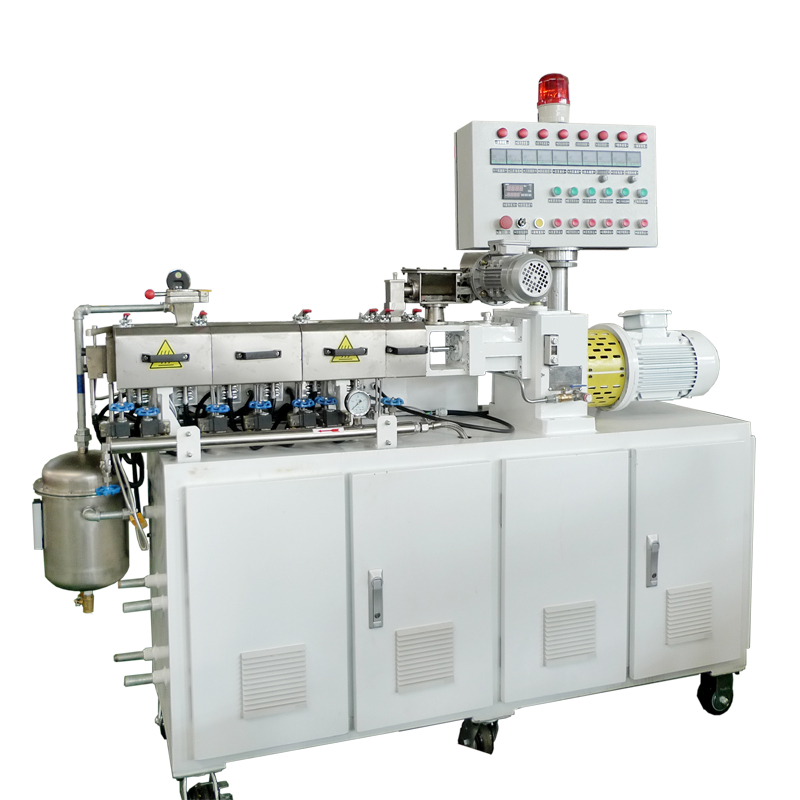Co-rotating twin-screw extruders, also known as intermeshing co-rotating parallel twin-screw extruders, are one of the main types of twin-screw extruders. Co-rotating twin-screw extruders have the advantages of high conveying efficiency, strong dispersion mixing ability, good self-cleaning performance, uniform distribution of material residence time in the machine, and good adaptability. They are widely used in the modification of blends between different plastics, between plastics and rubbers, blending of various additives with plastics, glass fiber, carbon fiber reinforced plastics, etc. They are the preferred equipment for continuous polymer modification mixing.

Structure features of co-rotating twin-screw extruder
Co-rotating twin-screw extruders are mainly composed of extrusion system, feeding system, transmission system, heating and cooling system, and control system.
Extrusion system: barrel, screw, and head connector (including porous plate)
Feeding system: hopper, feeder, and feeder transmission device
Transmission system: motor, gearbox, and thrust bearing
Heating and cooling system: the barrel has internal heating and liquid cooling channels
Control system: to implement the automatic control of the entire extrusion unit
The functions of each part are similar to those of a single-screw extruder, but the structure is much more complex than that of a single-screw extruder.
Modular screw design
The most significant feature of co-rotating twin-screw extruders is that both the screw and barrel are designed in a "modular" way. The screw is composed of several components, such as screw elements, kneading blocks, gear-shaped mixing discs, and retaining rings, which are installed on the core shaft. The barrel is also composed of different barrel sections (fully enclosed, with exhaust ports, with feeding ports).
According to specific materials, formulations, and performance requirements of the prepared mixtures, different types and numbers of screw elements and barrel elements are scientifically combined in a certain order to efficiently complete the mixing tasks. By changing the combination order of screw elements and barrel elements, the optimal use effect of different materials and formulations can be achieved, and the purpose of one machine for multiple uses and multiple functions can be achieved.
In addition, another advantage of the modular design is that worn screw elements and barrel elements can be replaced locally, avoiding the scrapping of the entire screw or barrel, and greatly reducing maintenance costs.
Modular barrel design
Modular barrel design, which can be connected by flange or tie rod, and tie rods are usually used for small machines. The barrel is usually embedded with bimetallic lining to improve the wear resistance of the inner surface of the barrel. Each barrel has a separate heating/cooling design to achieve the best combination of cooling and heating functions for accurate temperature history.
Extrusion process analysis
By combining various screw elements, all co-rotating twin-screw extruders have feeding, melting, mixing, exhaust, pressure building, and conveying functions to achieve various process processes such as material conveying, plasticizing, shearing, exhaust, pressure building and extrusion.
The structure and function of co-rotating twin-screw extruders are similar to those of single-screw extruders, but there are significant differences in working principles. The main differences are as follows:
Forced conveying
In co-rotating twin-screw extruders, the intermeshing twin screws rotate in the same direction, and the speed directions of the two screws at the meshing point are opposite. One screw pulls the material into the meshing clearance, and the other screw pushes the material out of the clearance, resulting in the material being forcibly conveyed toward the head in a "∞" shape along the screw.
1. Homogenization and mixing
The intermeshing co-rotating twin screws have a small clearance at the meshing point, and the speed directions of the screw teeth and grooves are opposite, with a high relative speed. Therefore, the meshing area has a high shear rate, a large shear force, and a far better mixing effect than single-screw extruders and counter-rotating twin-screw extruders.
2. Self-cleaning
In intermeshing co-rotating twin-screw extruders, the screw teeth and grooves at the meshing area have a high relative speed and a considerable shear rate, which can scrape off any adhering material on the screw and have a very good self-cleaning effect. Therefore, the material residence time is short, and local degradation and deterioration are not easy to occur.
3. Material plasticization
The clearance size between the screws has a great influence on the plasticization quality of the material. The smaller the clearance, the greater the shear force, but the amount of material passing through is reduced; the larger the clearance, the greater the amount of material passing through, but the shear force is reduced.
4. Material compression
The method of compressing the material of co-rotating twin-screw extruders is much more diverse, and the comprehensive effect is good.
5. Feeding method
Co-rotating twin-screw extruders require uniform and quantitative feeding and adopt a metering and starving feeding method.
6. Exhaust
Because it is a starved feeding, a large pitch screw element can be used to make the groove in a zero pressure state instead of being fully filled, so an exhaust section can be set up.
About us
Nanjing Chuangbo is committed to develop technology, engineering application, product manufacturing and turnkey projects such as, polymer compounding, reactive extrusion, post-reaction treatment, continuous and long fiber reinforced thermoplastics (CFRTP,LFT-G) lines, and carbon dioxide foaming extrusion lines and so on. In the field of polymer process, Nanjing Chuangbo is creating a leading brand in China and strive to maintain a good reputation all around the world.
Website: https://www.chuangboextrusion.com/
Welcome to contact us!



